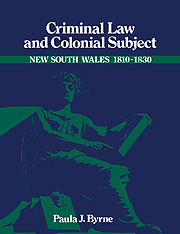Book contents
- Frontmatter
- Contents
- Figures
- Tables
- Author's Note
- Acknowledgements
- Abbreviations
- 1 Introduction
- Part 1 Law and the Person
- Part 2 Offence in the Wilderness
- Part 3 Suspicious Characters: Police and People
- 6 The Structure and Style of Policing
- 7 Popular Use of Law
- Part 4 The Courtroom
- Appendix
- Bibliography
- Index
6 - The Structure and Style of Policing
Published online by Cambridge University Press: 15 December 2009
- Frontmatter
- Contents
- Figures
- Tables
- Author's Note
- Acknowledgements
- Abbreviations
- 1 Introduction
- Part 1 Law and the Person
- Part 2 Offence in the Wilderness
- Part 3 Suspicious Characters: Police and People
- 6 The Structure and Style of Policing
- 7 Popular Use of Law
- Part 4 The Courtroom
- Appendix
- Bibliography
- Index
Summary
The convict system sought to regulate the person of the convict and his or her movement around the town. The administration also sought to regulate and control the free or freed person. This was met with considerable resistance in the form of skirmishes between constables and local people. Controls over the person developed not only from the administration but also from local populations. As we have seen, these local populations had their own uses for law and their own means of dealing with defendants and complainants. Thus policing combined with resistance and popular use of law to create the restrictions and freedoms of the colonial population, to create what was possible. As with bushranging, policing regulations do not reflect the reality of policing. In colonial New South Wales constables had their own interests and magistrates had their own interpretations of statute law.
In 1810 Governor Macquarie established a system of policing for the town of Sydney. This began a structure of street surveillance and house searching which was intended to make an impact on the social and economic lives of the inhabitants of the town. In many ways it was a fledgling and ineffective system. However, the focus of this policing and of the reformed system introduced by Francis Rossi in 1825 demonstrates an attempt to create a method of policing that was unknown in England.
The capacity of colonial administrators to develop new modes of policing in an untrammelled environment has been well recognised by legal historians.
- Type
- Chapter
- Information
- Criminal Law and Colonial Subject , pp. 155 - 207Publisher: Cambridge University PressPrint publication year: 1993



